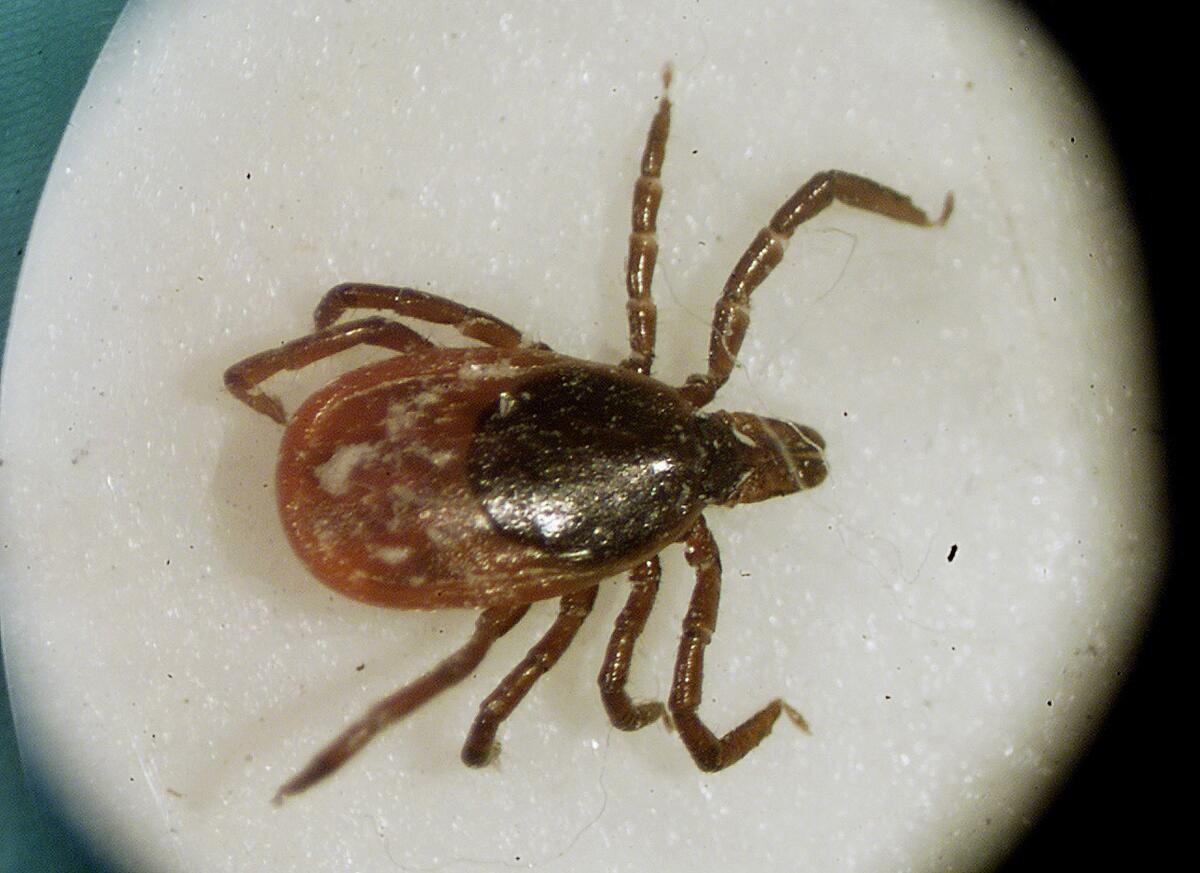Ticks on a ‘quest’ for blood at California’s beaches. Is Lyme disease a rising risk?

- Share via
MENLO PARK, Calif. — Millions of people enjoy hanging out at California beaches in the warmer months. So do ticks carrying Lyme disease.
That’s one finding from four years of field work in California’s San Francisco Bay Area and nearby wine country involving the collection of some 3,000 Western black-legged ticks.
The abundance of the blood-sucking arachnids surprised some tick biologists and experts, in part because it is unclear what animals may be spreading them around.
How these ticks survive, feed and breed in coastal areas remains somewhat of a mystery, said Dan Salkeld, an ecologist at Colorado State University in Fort Collins, who led the study. The ticks’ favorite mammalian host, the western gray squirrel, does not frequent seaside grass-scapes.
While the research is not yet published, it could be important in evaluating whether Lyme disease — a potentially debilitating tick-borne infection — is on the upswing in the Bay Area and statewide.
Linda Giampa, president of the Bay Area Lyme Foundation, said she has little doubt the disease has taken a stronger hold.
“It’s definitely increasing in ticks,” said Giampa, whose organization funded the research. “It’s basic ecology.”
Others, including Salkeld, say it’s difficult to determine a long-term trend.
“Looking at patterns of human cases across years isn’t straightforward — there may well be yearly variations, and the picture can be complicated by climate change, changes in awareness or surveillance of Lyme disease, et cetera,” he said. “It’s hard to determine a particular trajectory of human cases.”
Still, California has a far lower incidence of disease-carrying ticks than other parts of the country, particularly the East Coast, where up to half of all ticks can be carriers.
By contrast, surveys in Mendocino, Sonoma, Napa, Marin, Santa Clara, Santa Cruz and Monterey counties indicate a 4% incidence of the bacteria causing Lyme disease in ticks found in woodlands, grasslands and beach scrub.
Giampa said there are also hot spots farther south — in Malibu, Manhattan Beach and Newport Beach.
“I know it’s down there,” said Giampa, citing an ongoing study her organization is funding in Southern California.
The Centers for Disease Control and Prevention estimates that roughly 476,000 people contract the disease every year. Most of the cases occur in the Northeast, Middle Atlantic states and Upper Midwest.
Early symptoms of the disease, caused by a bacteria known as Borrelia burgdorferi, include fever, chills, fatigue and muscle aches and swollen lymph nodes. If left untreated, it can cause arthritis, swollen joints, facial palsy, heart irregularities, brain inflammation and nerve pain.
The disease is generally treated via a standard course of antibiotics. It is so common in the East Coast that physicians regularly prescribe antibiotics for patients reporting tick bites. In California, however, where the disease isn’t as well studied or encountered, recognition lags.
That’s where Giampa’s group is trying to make a difference, funding research such as Salkeld’s to both better understand the Western black-legged tick’s behavior and ecology, and to survey the incidence of the Lyme-causing bacteria in them.
The organization sponsored a citizen-science study, published in 2019, for which people across the nation collected and sent in ticks to a laboratory in Arizona for analysis. Between 2016 and 2018, the team analyzed more than 21,000 ticks from 49 states and found ticks capable of harboring Lyme disease in 24 states, including some unknown to have populations of either Western black-legged ticks or deer ticks — the common host in the East and Upper Midwest.
Ticks carrying the bacterium responsible for Lyme disease are infesting Northern California’s birds and may be hitching rides on them into suburban settings, according to a new UC Berkeley study.
And in January, a study showed that along the West Coast, the Western black-legged tick is likely to expand its range as the population grows and the climate changes.
Seemay Chou, a biochemist at UC San Francisco, is now working with Salkeld and others to examine other diseases in ticks, including viruses.
“We’re really trying to more fully canvass the Northern California regions,” for other microbes in ticks — attempting to uncover less-recognized tick-borne diseases.
As the footprint of these infectious ticks expands, it’s critical to know how and where it does so, say researchers and advocates — some of whom have a certain vernacular, describing how the arachnids are “questing,” in search of a “blood meal.”
Richard Ostfeld, an ecologist with the Cary Institute of Ecosystem Studies based in Millbrook, N.Y., said humans often create environments where ticks, and their hosts, thrive. On the East Coast, where Ostfeld conducts most of his research, the ideal host for deer ticks is mice; and they love the suburbs.
Along the West Coast, black-legged ticks favor lizards and squirrels — and, as this new research indicates, an as-yet unidentified host that frequents beach scrub. Ostfeld and Salkeld say lizards are unlikely to be that host, because they carry a biological agent that neutralizes the bacteria.
Ostfeld said he was not surprised to find the ticks beside the ocean, noting they prefer moist or humid environments. Other researchers say they’ve heard anecdotal reports that ticks are becoming increasingly prevalent across the state, even with current drought conditions. Said Salkeld: “I don’t know what that’s about.”
More to Read
Sign up for Essential California
The most important California stories and recommendations in your inbox every morning.
You may occasionally receive promotional content from the Los Angeles Times.














